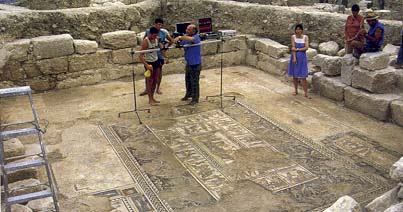Image Details

Eric Meyers/courtesy of the Joint Sepphoris Project
A magnificent villa, just south of the theater, offers striking evidence of the foreign cultural influences that left their mark on Sepphoris in the second, third and fourth centuries C.E. Contributing to the mix of cultures were the Roman troops headquartered just south of the city and the Jews who migrated to Galilee from southern Palestine during and after the Bar-Kokhba Revolt (132–135 C.E.). More hellenized than their Galilean counterparts, these southern Jews brought with them a greater familiarity with the language and customs of Greco-Roman civilization.
Dating to the third century C.E., the villa had a colorful mosaic floor in its triclinium, the banquet area/reception hall. Among its many well-preserved images, the mosaic features an exquisite portrait of a beautiful, but unknown, woman, often called the “Mona Lisa of the Galilee” (see photograph). The central portion of the mosaic contains 15 panels that depict episodes connected with Dionysus, the god of wine (see photographs).
